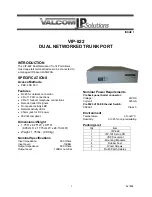
47
will be able to locate the Access Point (AP) of your router.
~
Disable:
When Disable is selected, you can allow anybody with a wireless client to be able to
locate the Access Point (AP) of your router.
Regulation Domain:
Select the
America (N.America)
.
Channel ID:
Select the ID channel that you would like to use.
Channel
Wdith:
Select either
20 MHz
or
20/40 MHz
for the channel bandwidth. The higher the
bandwidth the better the performance will be.
Tx Power Level:
The maximum transmitter power is17dBm±1.5dBm,
It is function that
enhances the wireless transmitting signal strength. User may adjust this power level from minimum
0 up to maximum 100.
Note:
The Power Level maybe different in each access network user premises environment and
choose the most suitable level for your network.
AP MAC Address:
It is a unique hardware address of the Access Point.
AP Firmware Version:
The Access Point firmware version.
WPS service:
Enable / disable
WPS State:
Current WPS state in AP. It is be used for WCN (Windows Connect Now).
~
Configured:
This AP is be configured via WPS. It is not allow to configure via WCN.
~
Unconfigured:
This AP is un-configured via WPS. It can be configure via WCN.
WMM:
This feature works concurrently with QoS that enables the system to prioritize the flow of data
packets according to 4 categories: Voice, Video, Best Efforts and Background.
~
Enable:
Click to activate WMM feature.
~
Disable:
Click to deactivate WMM feature.
Wireless Distribution System (WDS)
It is a wireless access point mode that enables wireless link and communication with other access
point. It is easy to be installed, simply define the peer’s MAC address of the connected AP. WDS takes
advantages of cost saving and flexibility which no extra wireless client device is required to bridge
between two access points and extending an existing wired or wireless infrastructure network to
create a larger network.
WDS Service:
The default setting is
Disable.
Check
Enable
radio button to activate this function.
1. Peer WDS MAC Address:
It is the associated AP’s MAC Address. It is important that your peer’s
AP must include your MAC address in order to acknowledge and communicate with each other.
2. Peer WDS MAC Address:
It is the second associated AP’s MAC Address.
3. Peer WDS MAC Address:
It is the third associated AP’s MAC Address.
4. Peer WDS MAC Address:
It is the fourth associated AP’s MAC Address.
Note:
For MAC Address, Semicolon (;) or Dash (-) must be included.
Summary of Contents for BiPAC 6200NXL
Page 91: ...87 3 Choose the directory which you want to delete then click Delete to romove this directory...
Page 92: ...88 Samba Server...
Page 98: ...94 Step 3 To continue click Next Step 4 Select network printer and apply Next button...
Page 100: ...96 Step 7 Click Finish to complete the add printer...
















































